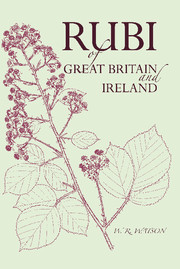Book contents
- Frontmatter
- Foreword
- Preface
- Contents
- INTRODUCTION
- I Environmental variations
- II Genetic intraspecific variations
- III Chromosomes and genes
- IV Reproduction
- V The species in Rubus
- VI Ecesis and migration
- VII Enemies, pests and diseases
- VIII Classification
- IX Collection and identification
- X Characteristics of the British-Irish bramble flora
- XI Cultivating native blackberries for fruit
- XII Note on the nomenclatural type species for the genus Rubus and subgenus Rubus
- XIII Key to the vice-county numbers
- XIV Signs and abbreviations
- ARRANGEMENT OF THE GENUS RUBUS LINN. IN AN ANALYTICAL KEY
- DESCRIPTIONS
- DRAWINGS
- Glossary
- Principal works consulted
- Index
- Frontmatter
- Foreword
- Preface
- Contents
- INTRODUCTION
- I Environmental variations
- II Genetic intraspecific variations
- III Chromosomes and genes
- IV Reproduction
- V The species in Rubus
- VI Ecesis and migration
- VII Enemies, pests and diseases
- VIII Classification
- IX Collection and identification
- X Characteristics of the British-Irish bramble flora
- XI Cultivating native blackberries for fruit
- XII Note on the nomenclatural type species for the genus Rubus and subgenus Rubus
- XIII Key to the vice-county numbers
- XIV Signs and abbreviations
- ARRANGEMENT OF THE GENUS RUBUS LINN. IN AN ANALYTICAL KEY
- DESCRIPTIONS
- DRAWINGS
- Glossary
- Principal works consulted
- Index
Summary
R. Chamaemorus (8x) is dioecious. It has been observed that where the male plant is absent the female plant does not set seed. Where male and female plants are together, seed is set. Sexual reproduction is thus clearly indicated.
When the styles of a bramble, e.g. R. procerus or R. caesius, are cut off, fruit is not produced; but when flower buds of either of the same two species are enclosed in a muslin bag, in late summer and in the shade, the flowers open and set fruit, self-pollinated. Thus, for fruit-production pollination is necessary, which is not the case for clone formation.
Many species successfully cross together, whether fairly closely related as R. ulmifolius and R. subinermoides or remotely related (if at all) as R. plicatus and R. Bellardii. They may give a fertile hybrid intermediate between the parents, and may have pollen and fruit as good as or better than those do; or they may be infertile and propagate solely by rooting stem-tips. Such intermediates are found sometimes in nature growing in the presence of the parent species. Examples are given under JR. ulmifolius and R. propinquus. All such plants, both parents and offspring, are clearly not clone-producing nor clone-produced.
Whoever observes brambles closely in nature, especially when they are in flower, will be aware that variations in the same species are frequent. Clones do not produce variations.
The claim has been made by cytologists and others that many species of Rubus are clones, and indeed that this is the usual method of reproduction except in diploids. The proof offered is that in R. nitidoides and R. thyrsiger the development of seed by apospory has been noted cytologically. A cell of the nucellus has budded and pushed into the embryo sac and, without the nucleus having undergone meiosis, has developed into a false egg.
But it has been observed in the same two species that two daughter cells (2x) in the normal embryo sac united again after having undergone meiosis. In this state (4x) they could, either with or without union with a sperm nucleus, grow into a true seed and pass on any variation acquired before meiosis.
- Type
- Chapter
- Information
- Handbook of the Rubi of Great Britain and Ireland , pp. 9 - 12Publisher: Cambridge University PressPrint publication year: 2013



